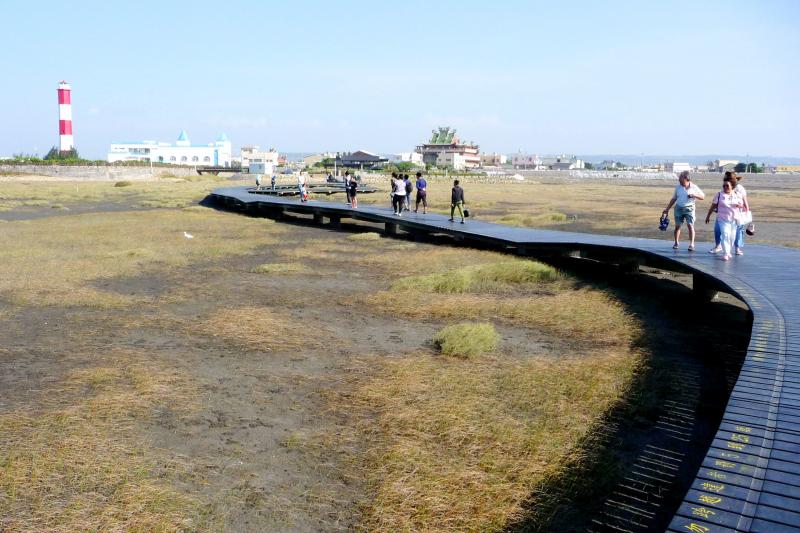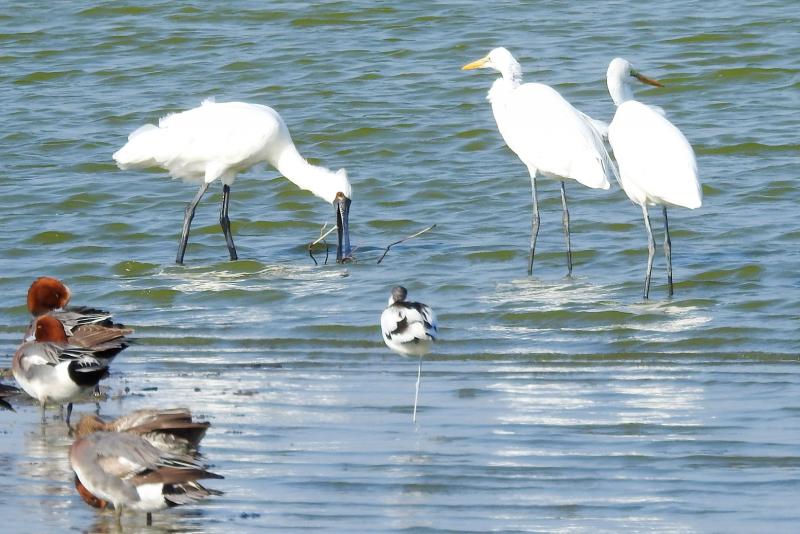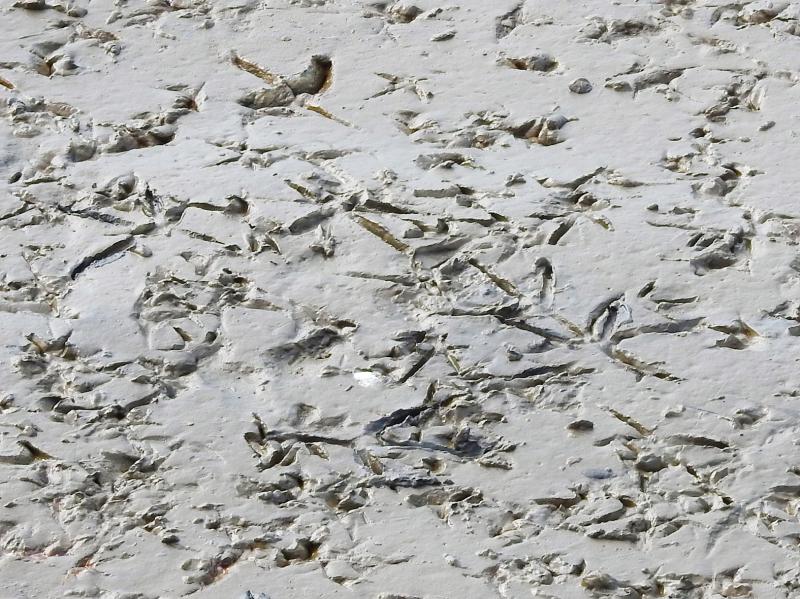Next Tuesday, Feb. 2, will be World Wetlands Day (WWD). An annual event since 1971, WWD celebrates the signing of the Convention on Wetlands of International Importance Especially as Waterfowl Habitat in Ramsar, Iran in 1971, and tries to raise awareness about the ecological importance of wetlands.
Between 1.2 and 1.6 percent of Taiwan’s total land area is wetland of some kind. The majority of wetlands, including all the larger ones, are on the west coast. Perhaps the best known inland bog is Fataan Wetland (馬太鞍濕地) in Hualien County’s Guangfu Township (光復). Taiwan is dominated by mountains, but very few wetlands are more than 100m above sea level.
It’s well known that wetlands filter contaminants from wastewater, such as the nitrogen, phosphorus and pesticides that taint agricultural runoff. Also, because they can soak up excess water, marsh-type ecosystems help mitigate flooding. Yet the extent to which bodies of water can reduce the temperature in the immediate area surprises many.

Photo: Steven Crook
According to research by Fang Wei-ta (方偉達), director of National Taiwan Normal University’s Graduate Institute of Environmental Education, and current president of the Society of Wetland Scientists Asia Chapter, temperatures across Taiwan have risen by an average of about one degree Celsius over the past 100 years.
Only one lowland region has shown no warming during this period: Taoyuan. Fang attributes this to the thousands of ponds that were dug to collect water for agricultural purposes. Unfortunately, urban sprawl and infrastructure projects have led to many of these ponds being filled in. By one estimate, the proportion of the municipality covered by water has shrunk from 11.8 percent to 3.8 percent.
The crustacean and insect species that thrive on mudflats and in swamps are essential food sources for birds.

Photo: Steven Crook
“Taiwan is a crucial way station on the East Asian-Australasian Flyway,” says Lin Kun-hai (林昆海), director-general of the Kaohsiung Wild Bird Society (KWBS), referring to the corridor through which vast numbers of birds migrate between their breeding grounds in the far north and warmer regions where they spend the rest of the year.
“But in the past 60 years, Taiwan’s coastal mudflats have shrunk by 60 percent, according to the Council of Agriculture’s Endemic Species Research Institute. Local wetlands face a range of challenges, including industrial and residential development, and the construction of solar-power plants,” Lin says.
The ability of several wetlands to cleanse water and nurture wildlife has also been seriously degraded, he adds.

Photo: Steven Crook
Lin acknowledges the central government is trying to protect wetlands through a legal framework established in 2015 by the Wetland Conservation Act (濕地保育法). Article 1 sets out the Act’s goals: “to ensure the natural flood control and related functions of wetlands in order to maintain biodiversity, and promote wetland ecological conservation and wise use.”
Each year, the Urban and Rural Development Branch of the Ministry of the Interior’s Construction and Planning Agency (CPAMI) approves a budget for conservation, ecological monitoring, environmental education and other wetland activities. Yet, Lin says, “central government subsidies for important wetlands have been shrinking every year.”
The Coastal Zone Management Act (海岸管理法), which also came into force in 2015, aims to “maintain natural systems, ensure zero loss of the natural coast, respond to climate change, prevent coastal disasters and damage to the environment, protect and restore coastal resources, implement integrated coastal zone management and promote the sustainable development of coastal zones.”

Photo: Steven Crook
PROTECTING WETLANDS
There are two avenues by which citizens can help protect local wetlands, Lin explains.
The first is cooperation, usually through NGOs, with local communities and the authorities. On behalf of the government, KWBS currently manages two bird-rich sites in Kaohsiung — Niaosong Wetland Park (鳥松濕地公園) and Meinong Lake Pheasant-tailed Jacana Habitat (美濃湖水雉棲地) — as well as Budai Salt Pan Zone Ten (布袋十區鹽田) in Chiayi County.
“Volunteers can get involved in removing invasive species, habitat construction, ecological monitoring and promoting public understanding of wetlands,” Lin says.
The second is by protesting.
“Through press conferences, press releases and other initiatives, we put pressure on government departments to halt improper development within or near wetlands. For example, we’ve had some success in our campaign against the building of solar-power arrays in wetlands and on fish farms,” Lin adds.
Taiwan’s recent push to massively expand its renewable-energy capacity, coupled with the designation of thousands of hectares of coastal flatlands as land subsidence areas suitable for conversion into photovoltaic power plants, has prompted something of a “gold rush.” Important bird habitats have already been damaged as entrepreneurs jump onto the solar bandwagon.
Just as the installation of photovoltaic equipment at a particular site might not be a change for the better, tearing up a mangrove swamp doesn’t necessarily mean a valuable ecosystem is being destroyed.
In many places, healthy mangroves equal a healthy wetland. However, in some cases — including two discussed by a pair of Taiwanese researchers in a 2019 paper published by Sustainability — the deliberate introduction of these trees has upset the ecological balance.
At Siangshan Wetland (香山濕地) in Hsinchu City, the planting of Kandelia candel after 1969 caused sediment to accumulate in the estuary. This threatened the wellbeing of Uca formosensis, an endemic fiddler crab species, and other crustaceans. At the same time, it created breeding grounds for Forcipomyia taiwana, a biting midge loathed by Taiwanese, who call it xiao heiwen (小黑蚊, “little black mosquito”). Since 2000, Hsinchu City Government has worked with NGOs to uproot more than 340 hectares of mangroves.
When the Ministry of Economic Affairs’ Water Resource Agency began planting Kandelia candel and Avicennia marina at Fangyuan (芳苑) in Changhua County, environmentalists warned that the mangroves would cause mudflats to build up, and change the structure of the coast to the detriment of organisms that live on and sieve sediment for food particles. These benthic creatures play a crucial role: They clean up the water, enhance its oxygen content by stirring the sediment, and serve as food for various fish species. The environmentalists were proved right, and in 2006 the authorities began removing the mangroves.
Attempts to estimate the total economic value (TEV) of different ecosystems have come up with wildly varying figures. However, when non-market ecological functions (climate regulation, protection against storm surges and the preservation of genetic resources for future use, for instance) are included alongside conventional extractive benefits (such food, fodder, building materials and recreation), the TEV of wetlands exceeds by far that of farmlands and other landscapes shaped by humanity — and is even higher than that of tropical rainforests.
One of the most detailed investigations into this issue is the TEEB for Water and Wetlands, published in 2013. Taxpayers and policymakers who’ve no interest in the birds and other creatures that thrive in this kind of landscape should keep in mind a point made in the report’s Executive Summary: “Maintaining and restoring wetlands in many cases also lead to cost savings when compared to man-made infrastructure solutions.”
Steven Crook, the author or co-author of four books about Taiwan, has been following environmental issues since he arrived in the country in 1991. He drives a hybrid and carries his own chopsticks.

US President Donald Trump may have hoped for an impromptu talk with his old friend Kim Jong-un during a recent trip to Asia, but analysts say the increasingly emboldened North Korean despot had few good reasons to join the photo-op. Trump sent repeated overtures to Kim during his barnstorming tour of Asia, saying he was “100 percent” open to a meeting and even bucking decades of US policy by conceding that North Korea was “sort of a nuclear power.” But Pyongyang kept mum on the invitation, instead firing off missiles and sending its foreign minister to Russia and Belarus, with whom it

When Taiwan was battered by storms this summer, the only crumb of comfort I could take was knowing that some advice I’d drafted several weeks earlier had been correct. Regarding the Southern Cross-Island Highway (南橫公路), a spectacular high-elevation route connecting Taiwan’s southwest with the country’s southeast, I’d written: “The precarious existence of this road cannot be overstated; those hoping to drive or ride all the way across should have a backup plan.” As this article was going to press, the middle section of the highway, between Meishankou (梅山口) in Kaohsiung and Siangyang (向陽) in Taitung County, was still closed to outsiders

Many people noticed the flood of pro-China propaganda across a number of venues in recent weeks that looks like a coordinated assault on US Taiwan policy. It does look like an effort intended to influence the US before the meeting between US President Donald Trump and Chinese dictator Xi Jinping (習近平) over the weekend. Jennifer Kavanagh’s piece in the New York Times in September appears to be the opening strike of the current campaign. She followed up last week in the Lowy Interpreter, blaming the US for causing the PRC to escalate in the Philippines and Taiwan, saying that as

The Chinese Communist Party (CCP) has a dystopian, radical and dangerous conception of itself. Few are aware of this very fundamental difference between how they view power and how the rest of the world does. Even those of us who have lived in China sometimes fall back into the trap of viewing it through the lens of the power relationships common throughout the rest of the world, instead of understanding the CCP as it conceives of itself. Broadly speaking, the concepts of the people, race, culture, civilization, nation, government and religion are separate, though often overlapping and intertwined. A government